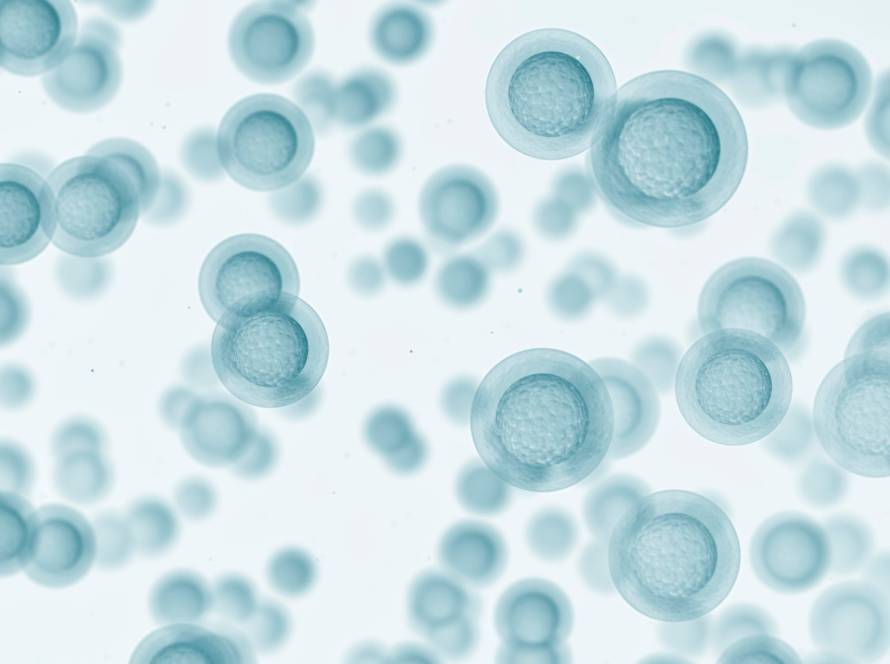B cells make up an impressive 5-25% of all human blood cells. The question “are b cells part of the innate immune system” doesn’t have a simple answer. Scientists have analyzed our body’s defense system and found two main branches. The innate immune system provides quick but general protection, while the adaptive system delivers targeted responses.
In this piece, we’ll explore how B cells create a bridge between innate and adaptive immunity, the fascinating overlap that makes B cells’ role crucial to longevity research.
Do B cells belong to the innate or adaptive immune system?
B cells are not part of the innate immune system. They belong to the adaptive immune system, which means they respond to specific threats and build memory over time. B cells produce antibodies that target certain viruses or bacteria, helping the body fight off infections more effectively if they return. Although some types of b cells show faster, innate-like responses, they are still considered part of the adaptive branch due to how they recognize and react to antigens.
Overview of the immune system
The immune system works as a complex network of organs, cells and proteins that protect our bodies from harmful invaders. This defense mechanism has two connected systems that work together to shield us against pathogens.
Innate immunity: fast, general defense
Our body’s first line of defense comes from the innate immune system. It responds quickly, within minutes to hours after detecting potential threats. This system reacts the same way to all foreign substances, which is why experts call it “non-specific” immunity. The original protection starts with physical barriers. Our skin and mucous membranes block pathogens from entering the body. The innate response kicks in when something breaks through these barriers:
- Cellular components like phagocytes (macrophages, neutrophils), natural killer cells and mast cells;
- Soluble mediators such as lysozyme, defensins and complement proteins;
- Chemical barriers like stomach acid, tears and mucus.
These components team up to spot common threat patterns that many pathogens share instead of targeting specific invaders. We can spot this response through inflammation, which shows up as heat, redness, pain and swelling.
Adaptive immunity: specific, long-term protection
The adaptive immune system differs from innate defenses by providing custom responses to specific pathogens. This system takes more time to get going, days to weeks for full activation during the first encounter. The core team of this system includes two types of lymphocytes: B cells and T cells that target threats with precision.
What makes adaptive immunity amazing is its incredible specificity. These cells use special receptors to recognize and fight against any possible antigen they might encounter. The system creates an immunological memory that leads to faster and stronger responses when it meets the same pathogen again. This memory feature is what makes vaccines work.
Key differences in recognition and memory
The difference between these systems goes beyond how fast they respond. Pattern recognition receptors in the innate system are germline encoded and stay the same throughout life. The adaptive system creates antigen receptors through somatic recombination, which results in many highly specific receptors.
Memory cells are the standout feature of adaptive immunity and some can last for decades. Studies show that some innate immune cells might develop “trained immunity” through epigenetic changes after their first encounter with pathogens.
These systems don’t work alone. They cooperate extensively. The innate response often starts and guides the adaptive response through antigen presentation and cytokine signaling.
What are B cells and what do they do?
B cells are remarkable immune sentinels that develop in bone marrow and mature in peripheral tissues. These specialized white blood cells defend our bodies against pathogens through sophisticated mechanisms that go beyond antibody production.
B cell development in the bone marrow
B cell development begins in the bone marrow as hematopoietic stem cells undergo a tightly controlled process. The developmental path requires sequential rearrangement of immunoglobulin genes. Heavy chain genes rearrange first, followed by light chain genes. B cells express a pre-B cell receptor that signals successful heavy chain rearrangement during development. Bone marrow stromal cells produce IL-7, a cytokine that drives proliferation and differentiation at this stage. Immature B cells display functional IgM molecules on their surface before they head over to peripheral tissues.
Function of B cells in producing antibodies
B cells excel at producing antibodies, specialized proteins that recognize and neutralize pathogens. These cells transform into antibody-secreting plasma cells after activation by antigens with T cell assistance. Each plasma cell can release approximately 2,000 antibody molecules per second. Mammals produce five distinct antibody classes that trigger different biological responses:
- IgM: first antibody secreted during primary immune responses;
- IgG: predominant antibody in blood and only type that crosses the placenta;
- IgA: primary antibody in secretions (tears, saliva, milk);
- IgD: expressed alongside IgM on mature naïve B cells;
- IgE: binds to receptors on mast cells and basophils.
Memory B cells and long-term immunity
Memory B cells provide long-term protection after infection or vaccination. These cells persist without secreting antibodies, unlike short-lived plasma cells. They multiply quickly upon re-exposure to the same pathogen. Memory B cells form early in immune responses, while long-lived plasma cells develop later. These cells position themselves strategically in lymphoid organs and infection sites to respond swiftly. The cells in tissues like lungs offer immediate protection at infection entry points.
B cells as antigen-presenting cells
B cells serve as professional antigen-presenting cells beyond their antibody-producing role. They process and present antigens to CD4+ and CD8+ T cells using both MHC class I and II molecules. B cell receptor recognizes antigens that are internalized, processed and presented with exceptional efficiency through BCR-dependent mechanisms. B cells can capture antigens through BCR-independent pathways as well. These interactions help activate T cells and coordinate immune responses effectively.
Are B cells part of the innate or adaptive immune system?
B cells are part of the adaptive immune system, unlike their innate counterparts. Their sophisticated abilities to generate specific responses against pathogens through specialized mechanisms set them apart.
Why B cells are classified as adaptive
B cells play a central role in the adaptive humoral immune system and they produce antigen-specific immunoglobulin that targets invasive pathogens. Three key characteristics make them adaptive immune cells. B cells’ gene recombination creates a repertoire of membrane-bound immunoglobulins (mIg). These cells also create memory cells that become the immune system’s long-term defense. The response time sets them apart, B cells need days to mount effective responses, which distinguishes them from innate immunity that acts within hours.
How B cells recognize specific antigens
B cells use their membrane-bound immunoglobulin as a B-cell receptor (BCR) that recognizes antigens with remarkable precision. Each antibody binds different specific antigens through its variable region or V region, which shows extensive variation between antibody molecules. The BCR starts a signaling cascade after antigen recognition. This process happens quickly, Lyn kinase phosphorylates immunoreceptor tyrosine activating motifs (ITAMs) within seconds and activates several downstream pathways.
Timeframe of B cell activation and response
The activation process starts at the time naïve B cells meet antigens in peripheral lymphoid organs follicles. A series of events follows this meeting. Small, soluble antigens reach follicular B cells within 2 hours, while larger antigens like viruses need more time. B cells move to the T-cell zone boundary after successful contact. The entire process of differentiation takes days to weeks, which includes germinal center formation, antibody class switching memory cell development. This timeline runs longer than innate responses. Such an extended period shows the complexity needed to create highly specific, lasting immunity.
Innate-like B cells: the overlap zone
The sort of thing I love about B cells is how they defy simple classification. While traditionally viewed as adaptive immune cells, some B cell subsets blur the line between innate and adaptive immunity. These innate-like B lymphocytes (ILBs) work faster than conventional B cells and respond to pathogens with less specificity.
B-1 cells and their rapid, non-specific response
B cells have found their home in peritoneal and pleural cavities. These locations house up to 80% of B cells. Unlike conventional B cells with their specific responses, B-1 cells produce natural antibodies that show low affinity and poly-specificity. B-1 cells create over 80% of natural serum IgM. These cells do more than produce antibodies, they act as professional phagocytes. They capture larger bodies (>0.5 µm) through actin polymerization. When faced with an antigenic challenge, B-1 cells move from cavity sites to secondary lymphoid tissues and secrete antibodies faster.
Marginal zone B cells and their role in early defense
Marginal zone (MZ) B cells sit at a crucial spot in the spleen’s marginal zone, right where circulation meets the immune system. These cells show a pre-activated state with looser nuclear chromatin and higher baseline levels of co-stimulatory molecules CD80 and CD86. MZ B cells jump into action against blood-borne pathogens, particularly when dealing with encapsulated bacteria like Streptococcus pneumoniae. People without spleens face greater risks of pneumonitis, meningitis and septic syndrome from these bacteria.
TLR activation and cytokine production
B-1 and MZ B cells carry high levels of Toll-like receptors (TLRs), with TLR2, TLR6 and TLR7 being most abundant. These cells produce large amounts of cytokines, especially IL-10, when TLRs get stimulated. MZ B cells stand out as the main source of B cell IL-10 in the spleen. Some B-1 cells, known as “innate response activator” (IRA), travel from body cavities to spleen or lung after TLR stimulation. They boost inflammatory responses by secreting GM-CSF and IL-3.
Bridging innate and adaptive immunity
Innate-like B cells help bridge the time gap between immediate innate responses and slower adaptive immunity. These cells kick start rapid antibody responses while adaptive immunity develops. This happens through combined activation of BCR and TLR molecules by conserved microbial patterns. On top of that, they present antigens to T cells and help them differentiate into various subtypes.
B cells are core components of the adaptive immune system, though some subpopulations show remarkable innate-like properties. Their dual nature makes them the sort of thing I love about our body’s defense mechanisms.
B cells’ versatility without doubt contributes to their key role in immune function. They serve as professional antigen presenters, cytokine producers and immune regulators, functions that span both innate and adaptive systems. This complexity helps explain why disruptions in B cell populations can profoundly affect immunity and longevity.


